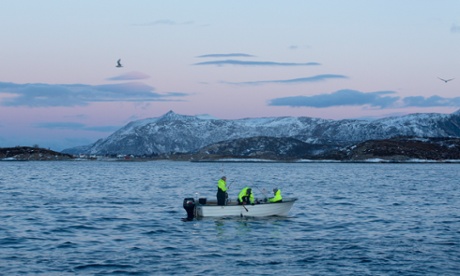
Extreme cod feasting – as practised in northern Norway in the darkest days of the year – reaches its finest expression with a dish called Skreimølje. This is served with the warning that you should make sure there’s a bed near the table. You will need it to collapse on when you’ve finished this protein bomb, a nose-to tail guzzle of one of the world’s most nutrition-laden fish.
These are skrei, which translates as “wanderer cod”. They are habitués of the Barents Sea, the stretch of water between northernmost Europe and the polar ice cap. Every year, the mature Arctic cod journey west along the Russian and Norwegian coast for several thousand miles, looking for somewhere to spawn. On the way, they gorge themselves with herring, while swimming hard to remain firm and lean. By March they are, in eating terms, at their very best.
Out on a fjord off Sommarøy, an ice-bound island an hour from Europe’s northernmost city, Tromsø, a bunch of skrei-loving British-based chefs and I were given a chance to catch one as guests of the Norwegian Seafood Council. Most skrei are now line-caught, rather than netted. They cannot be bruised or marked and they must be properly drained of blood to qualify as what’s now a trademarked premium fish. Trawled cod, even though sold in the fishmonger as “fresh”, may have lain around on ice in a ship’s hold for 10 days or more. Line-catching, of course, avoids the discards and other sad waste that comes with trawling.
We baited our hooks with chunks of herring and put the lines down in the Arctic twilight. It was busy out on the blue-black water – like a fishing trip at SeaWorld. Jostling on the water for the migrating herring was a school of humpback whales, none of them with much regard for traffic rules. An upright black dagger, an Orca fin at least 4ft high, circled the little trawler near us as it pulled in its haul.
There was, though, no shortage of fish. Chefs yelped as they pulled in cod after cod: Simon Hulstone of The Elephant in Torquay claimed the biggest (it got away), but Bocca di Lupo’s Jacob Kenedy proved pretty good too. He landed half a dozen of the big-bellied, green-backed monsters. Not much skill was needed. When I got a go with the rod I had three fish on it within a minute: one was nearly as long as my leg.
Back at the fish factory, the catch was landed, gutted and sorted, the best of the fish reserved for the skrei label. The cod heads, some as big as a Labrador’s, went off to be salted and dried, to be exported to the markets of west Africa. Above the salting room, we watched as our cod was cooked by two women from the village in traditional style: Viking one-pot cuisine. You can’t get complex cooking facilities in a longboat. So the cod is boiled: the fillets of the glossy white, the pale pink roe, the cheeks. For sauce, there’s the cod’s liver, chopped and simmered in its own oil. That was poured over the rest, with a bonne bouche of cod tongues (fried in cod oil) on the side. The Norwegians eat this with flatbread and strong red wine.
It was very good – the cod flaking into curls like good surf, the meat squeaky on the teeth, and the cod oil sauce buttery and delicate – nothing like the stuff I got dosed with as a kid who needed “building up”. This is very healthy – in a vitamin D-starved world, where 80% of Britons are deficient and the Dickensian disease rickets has made a comeback, you could do worse than going on a skreimølje regime. According to a Norwegian analysis, one plate of it contains the equivalent of 12 days’ dosage of vitamin D. It may be this that keeps the Arctic Norwegians going in the 58 days every year when the sun never rises. Notably, they don’t guzzle Prozac the way the rest of northern Europe does in winter.
Not all the chefs were convinced by skreimølje, but they were sold on skrei. Jacob Kenedy left Norway determined to make a terrine with the slippery cod livers. Michel Roux Jr, a fan of the “snowy, translucent flakes” has been serving skrei at Mayfair’s Le Gavroche for a couple of years, most notably roasted with a teriyaki sauce. Simon Hulstone poaches the cod’s tongues as a bonne bouche, but his favourite way of serving is a cod fillet pan-roasted with lardo ibérico (cured ham fat), and a sauce of pureed parsnip and other sweet things. Hulstone’s recipe is here) and you can get hold of skrei cod at Booths supermarkets and selected fishmongers including London’s Moxon’s and Steve Hatt.
Still, I’m not sure skrei needs much prettification. Viking-style was pretty good, the greatest pleasure being in finding out what cod, really fresh and beautifully treated, actually tastes like. It is a long way from a fish finger.

